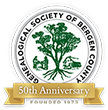The following is reprinted from a recent issue of The Archivist, The GSBC's quarterly newsletter distributed to our Members. If you enjoy this sample article, genealogy, or local NJ history, please consider joining the GSBC. Your membership dollars ($20 per membership year) help us provide a wide array of programming, research, indexing, and education — benefits which are designed to inspire your own research progress.
GSBC General Meeting Recap (Updated January 2015)
On 24 April 2012, GSBC member and the Ridgewood Library Local History Librarian, Peggy Norris, presented tips and tricks for getting the most out of the newly-released 1940 U.S. Federal Census.
Summary by Ray Ralph
At the start of each decade the U.S. Census Bureau takes a picture of our national life. Mandated by the U.S. Constitution, the decennial U.S. Census is the largest and most complete population count in the world.
On 2 April 2012, the National Archives and Records Administration made the manuscript records from the 1940 Census available to the public for the first time, following the 72-year embargo. The 1940 Census achieved deeper insights into American life than previous censuses, coming at the threshold of a word war and the ending of the prolonged depression. Having the chance to examine this census data gives us a chance to see how much our nation has changed in 72 years and gives us as genealogists a profound opportunity to find more links into our families' personal past. The link for the census is http://www.census.gov/1940census. The site experienced 22.5 million hits in the first three hours — which overwhelmed the servers and shut the site down mere minutes after it was launched.
In her presentation, Peggy described the range of questions asked by the enumerators in 1940, which were more insightful, numerous, and detailed than in previous Censuses. She also outlined the steps needed to find your ancestors — prior to the completion of indexing or if their names were mis-trascribed or mis-indexed. Finally, Peggy encouraged the audience to participate in that process by becoming an indexer, for this and other projects, which can help you achieve a great level of personal satisfaction, community, and improve your transcribing skills.

Above: The 1940 Census Schedule for Totowa Road, Totowa, NJ. Highlighted is GSBC Archivist Editor Michelle Novak's great-grandparents, Raymond Berdan and Nellie Braen-Berdan. Nellie Berdan (pictured, inset) is listed on line 29 — one of the lines pre-designated for supplementary questions (at bottom).
Ancestry.com. 1940 United States Federal Census [database on-line]. Provo, UT, USA: Ancestry.com Operations, Inc., 2012; Year: 1940; Census Place: Totowa, Passaic, New Jersey; Roll: T627_2379; Page: 14A; Enumeration District: 16-149. Original data: United States of America, Bureau of the Census. Sixteenth Census of the United States, 1940. Washington, D.C.: National Archives and Records Administration, 1940. T627, 4,643 rolls.
What Will You Find in the Census?
Each page reveals the actual information provided to the census taker — including the name of the head of the household, all residents of that household along with their relationship to the head, the occupation of each person, schooling levels, place of birth, immigration status, home ownership and home value, as well as 1935 residency, income level, weeks worked that year, and wages earned. Peggy encouraged researches to "read everything; do not overlook anything", especially the supplemental questions.
In addition, the 1940 U.S. Census included and supplemental question to be asked of two respondents. Those whose name appeared on the 14th, 29th, 55th, or 68th line of the Census were asked a number of additional detail questions which are noted on the last two lines of each schedule page.
How does one locate a particular family?
At the release of the 1940 U.S. Census, very few indexes were prepared (the bulk of the indexing was completed by volunteers and for-profit companies, all working under the organization of FamilySearch and NARA) and only 17% of the indexing was complete at the time of Peggy's talk. Without searchable indexes, early researchers used an alternate method to locate their family — and some whose family may have been indexed incorrectly can use the same research tools.
The first step is to find a family's 1940 address. If you don't know it, online phone books or city directory may be helpful. Once you have an address, you can use Steven Morse's Unified 1940 Census Ed Finder to locate the family's Enumeration district (ED) number. From there, you can locate the images of the Census pages online for this ED and scroll through, page by page, to locate your family.
Remember, if you do not find them on the first pass, make sure to continue through the entire ED section. Enumerators visited houses in order, and if a family representative was not home, the returned to the property on later dates until the family was accounted for in the Census. As such, you will find residents of one street scattered throughout the pages of the Census.
How and why should one become an indexer?
Peggy suggested that one might volunteer for this activity out of curiosity, to impress one's relatives or other genealogists, to gain more insight into the process and enhance knowledge of the census, as well as to contribute to a major national genealogical undertaking by "being part of something important" thus facilitating free access to these records for future genealogists. FamilySearch is coordinating the indexing, which is sponsored by NARA.
Finally, Peggy reminded everyone to record all citations for future reference and a complete personal genealogy record.
Helpful Links
FamilySearch 1940 Census: http://1940census.archives.gov
Ancestry 1940 Census: http://www.ancestry.com/1940-census
National Archives 1940 Census Page: http://www.archives.gov/research/census/1940/
Steve Morse's One-Step Webpages: http://www.stevemorse.org
IPUMS — Information about the US Census, Enumerator instructions, Questions, and other information: https://usa.ipums.org/usa/

